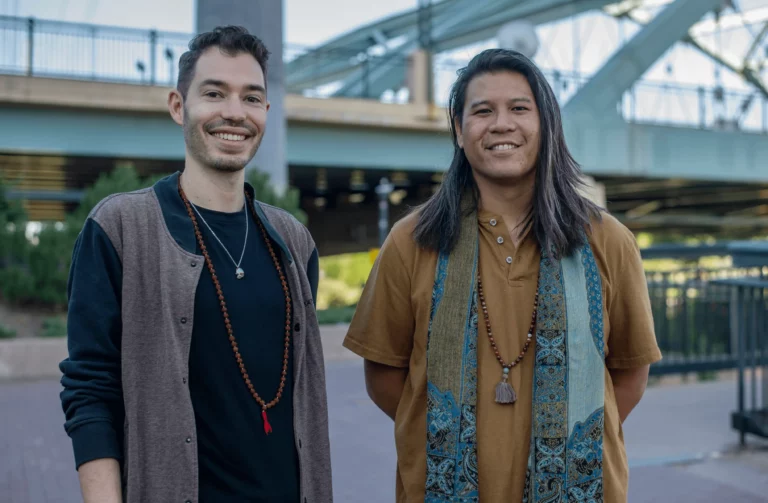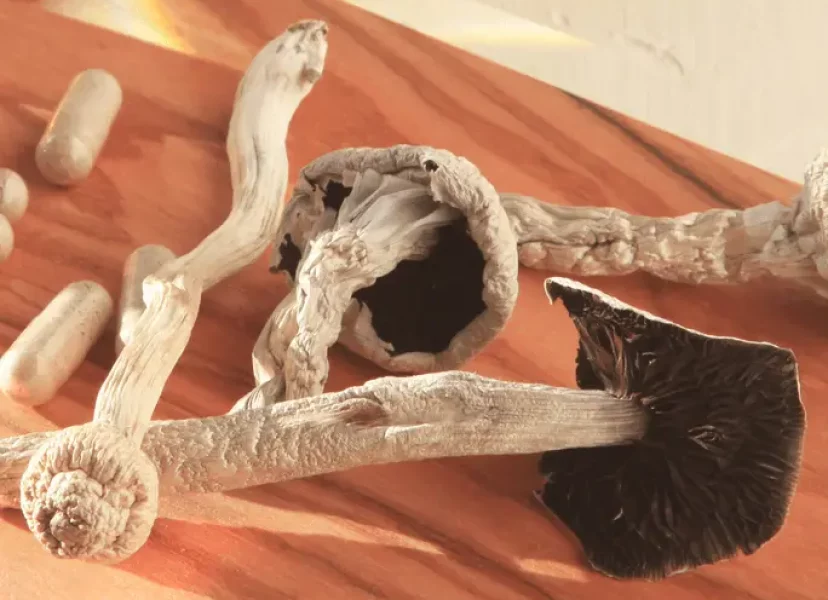You’ve tried everything—nicotine patches, gum, lozenges, rehabilitation therapy, maybe even those sleek essential oil vapes marketed as an alternative for satisfying oral fixations, and probably worst of all, quitting cold turkey.
To no avail, your addiction only seems to be picking up speed, snowballing through all of the stability-setting boundaries that up until now, had remained far from the elusive grip of your pervading vices.
Though motivations waver, you’re still determined to make a backdoor exit, to evict the sanity-swindling cravings that’ve found sanctuary living in your mind, rent free. Cue the psilocybin. Recently, the Youtube algorithm seems to be pushing ‘Psilocybin-Assisted Therapy’ into your daily news feed.
You watch as two middle-aged women persuasively proclaim the life-changing, addiction-breaking potential of these trippy, mind-altering fungi. Could it be true? Is all of this psychedelic talk legitimate or have we fallen victim to the convicting straws of our own golden dream cocktails?
Lucky for us, today’s discussion will touch on all of this and much more. From the credible scientific studies that’ve given psychedelics their claim to fame, to the underlying neurological mechanisms that potentiate their craving-suppressant effects—you’ll almost-surely walk away from this article feeling much less on-the-fence about this emerging drug-therapy combination.
We also encourage you to stick around till the end for an inside look at a psilocybin-assisted journey that annexed the alcoholism recovery process of one of our very own clients. First, let’s discuss some of the primary definers of addiction in the U.S.
Defining Drug Dependency
Of course, addiction can take on many forms, latching onto substances like alcohol, opioids, nicotine, prescription drugs, heroin, food and even sugar. Shopping, sex, video games, theft, and gambling comprise the umbrella of behavioral addictions—and it doesn’t help that our drug dealers are no longer street-bound, toyota-corolla driving highschool sweethearts.
Instead they’re overly-submissive, white-coat wearing doctors with good intentions, but no-so-good judgements, who lack the resources to maintain a close eye on their opioid-prescribed surgical patients. Now, we say this not with the intention to minister distrust or resentment toward our predominantly conscientious healthcare workers, but to encourage open discussion on the far too prevalent pitfalls of prescription drugs.
A very severe downfall of the addiction recovery industry, sits in the widely accepted definitions that have come to stipulate what an addiction comprises, what it looks like, and how it behaves. In truth, addictions aren’t necessarily confined to behavioral habits, they can latch onto a large spectrum of cognitive dependencies.
Anything that produces dopamine can translate into an addiction. For example, the anxiety caused by OCD is often neurochemically suppressed by an excessive release of dopamine that accompanies ritual-like compensatory fixations. That doesn’t mean that someone with OCD enjoys their anxiety, but it does mean that their brain has created a cyclical habit of feeling neurochemically satiated by the tug and pull of anxiety and its ensuing fixations.
Addiction is progressive, meaning that tolerance rises in proportion to receptor desensitization by neurotransmitters, requiring more stimulation to evoke consistent feelings of satisfaction, and to keep DMN overactivity at bay (more on this later). By understanding this, we can attribute addiction to a much broader scope of internalized events.
Any emotion or pattern of thought that provides relief, distraction, or escape, has the potential to promote molecular tolerance. Be that anger, grief, resentment, stress, or even emotional dependency on a romantic partner.
As of 2021, 4.4 percent of 12th graders reported misusing prescription drugs in the last year, with 3 percent of 8th graders abusing amphetamines within the same time frame, and 9.3 million Americans over the age of 12 reporting misuse of prescription pain relievers—that’s more than 3 percent of our country’s population!
With over 16,400 annual fatalities linked to prescription opioid overdose and a whopping 14.5 million people (aged 12 and up) reporting alcohol use disorder in 2019, it’s evident that our addiction rehabilitation procedures are in need of some serious revamping. Now that we’ve looked over the disappointing, but unfortunately unsurprising national prevalence of substance abuse, let’s get into the nuts and bolts of addiction.
Your Brain On Addiction
In the midst of an active addiction, most substances and habitual behaviors produce eerily similar effects on the brain. For one, addictions severely influence the mechanical trajectory of the default mode network (DMN).
As its name suggests, the DMN is responsible for curating those ruminating thoughts that circulate in our heads by default. Think showering, cooking, and even those few minutes before falling into a deep sleep. The DMN essentially maneuvers the conceptual undertones of this radio-like mental static, instinctively filling unconscious gaps of silence with the debris of our contemplative routines.
When our focused attention is absent, this white noise takes the shape of anxious concerns and like a broken record, it’s enamored by shameful memories of the past, conjuring strategic foresights to compensate for a practical lack of emotional structure and control.
In people suffering from addiction, the anterior DMN demonstrates a significant reduction in resting functional connectivity (RSFC), catering a complicated relationship between our self-perceived value and our cognitive capacity to exhibit emotional awareness. Sound familiar? If so, this next fact might knock you out of your socks.
Brain images produced by Magnetoencephalography (MEG), show an equally compelling increase in the RSFC of the posterior DMN. This increase can be attributed to a heightened prevalence of internally-directed thoughts, it’s what some would call ‘being trapped in your own mind’, or more simply, overthinking. A deviancy in DMN functions puts addiction-related ruminations and overall negative emotions into hyperdrive.
In a study conducted by Rui Zhang et al., on addiction-induced DMN dysfunction, the DMN exhibited cleaved connectivity with other vital executive function brain structures like the anterior cingulate cortex and medial orbitofrontal cortex.
This physical impairment translates into many of the emotional monoliths experienced during addiction, such as dysregulation of our chemical reward systems, disordered decision-making, and memory-linked salience attribution- producing the brain’s heightened affinity for drawing one’s selective attention to drug-associated cues above all other environmental stimuli.
Salience attribution can be largely blamed for prompt-triggered relapse. During stages of withdrawal, the DMN is highly involved with craving-related fixations, suppressing rule-based problem solving and goal-directed behaviors of the CEN (Central Executive Network).
In fact, the study found that when engaged in active phases of intoxication, DMN activity temporarily decreases, halting ruminating thoughts due to chemical satiation from the substance, inadvertently keeping us tied to the anxiety-relieving sensations of alcohol and other addictive substances.
Fundamentally, the DMN is keeping your past addiction-related thoughts in circulation, even after you’ve ceased drinking or smoking. Until our conscious thinking habits drastically change over a long period of time, the DMN will continue to collect and redistribute the craving-relating scraps of our cognizant minds.
Aside from DMN disruption, addiction also propounds changes in serotonergic, glutamatergic, dopaminergic and GABAergic neural circuits. In short, the neurotransmitters—serotonin, dopamine, glutamate, and GABA, mediate functions of satisfaction/reward, synaptic signaling for learning and memory, and regulation of neural hyperactivity correlated with stress and fear.
In a 2014 study by Niladri Banerjee, Neurotransmitters in alcoholism, we learn that glutamate reinforces and maintains addiction by expressing hyperexcitability during intoxication, triggering serotonin and dopamine production and thus conditioning/teaching our mechanisms of memory to favor a substance for its stimulating effects on our satisfaction and reward systems. Thus, a compound that reduces intemperate glutamate production would promote equilibrium in the brain, to encourage a more productive addiction recovery process.
Your Brain on Psilocybin
Tryptamines like psilocybin and LCD influence potent neuroplastic changes in our brains. Using electrophysiology and fluorescence microscopy, a 2018 study by Calvin Ly and colleagues, found that serotonergic psychedelics increase the growth of neurites (neuritogenesis) and dendritic spines (spinogenesis) from a cell, by stimulating the signaling pathways of TrkB (protein traffic), mTOR (gene transcription and protein synthesis), and 5-HT2A (serotonin receptors).
Picture this as a very literal limbic extension, allowing cells to physically extend their neural outreach to increase points of neuronal contact and foster larger and stronger signaling pathways for cell communication. In fact, a 2021 study led by Ling-Xiao Shao et al., found a 10% increase in both the number of and length of neuronal connections after consumption of psilocybin.
This is all to say that psychedelic-assisted therapy with psilocybin can effectively counter DMN synaptic signaling disruptions brought on by chronic substance use, reducing side effects of rumination, brain fog, and reduced dopamine production during withdrawal.
By compensating for the atrophy of cortical neurons that result from mood instabilities and anxiety disorders, psychedelic compounds can magnify psychological openness and suggestibility.
This can be particularly constructive during psilocybin-assisted therapy sessions, where an enhancement of psychological openness can allow for more vulnerable, free-flowing discussion, both internally and externally.
Where in the past you may have experienced difficulty understanding and communicating the roots of your addiction, increased suggestibility can influence feelings of surrender and acceptance, yielding productive inner dialogues that reframe mental narratives.
This, paired with the aforementioned remodeling of DMN circuits and the focused intent to address your addiction, can help significantly recondition our internal associations between substance use and reward, instead fortifying a bond between acceptance-based states of mind and neuronal satisfaction.
As I’m sure many have come to learn, 12-step recovery programs place a large emphasis on admitting powerlessness over addiction, scrutinizing our moral inventory, and making amends with those we’ve harmed.
Psychedelics like psilocybin are famous for evoking overwhelmingly positive feelings of interconnectedness and love. They help ground us into a very tactile sense of “all for one, and one for all,” sustainably lowering our internal defenses by realizing a more all-encompassing perspective of societal and familial unity.
Of course, this could be of immense benefit when trying to integrate the spiritual pillars of recovery, detaching our psyche from the form-bound mental matrixes of our ego, to permit more honest and unashamed conversations with those who are dearest to our hearts.
Adopting a less condensed sense of self allows us to more deeply meditate on our conscious and unconscious relationship to our addiction, solidifying a stronger connection to the whole of our lives, while offering wise revelations that can be relayed to the broader community of recovering addicts (Step 12).
An Internal Case Study on Psilocybin & Alcoholism
Meet Justin, a sharp and composed 56 year-old man, born in 1966. Though Justin’s career has boasted much financial and professional success throughout his adult years, his childhood was far from stable.
Riddled with emotional abuse at the hand of his own father, Justin’s trauma coerced a violent struggle with alcoholism that shadowed the entirety of his early adulthood, romantically pursuing him into his late 50s.
For Justin, money was not an issue, over the course of several years he stepped in and out of recovery at some of the world’s premier rehab centers, from luxury estates in Malibu to opulent, first-class programs in Laguna Beach, the seduction of his alcoholism seemed to meet no end.
His addiction led him astray from his wife and family and it’s at this point, when Justin’s search for alternative treatments would land him in the evocative embrace of intentional psilocybin use.
In June 2021, Justin came to us with an admittedly well-informed consensus on these emerging treatments. Lamenting the prominent challenge of sustaining his sobriety outside the alcohol-proof doors of sober living, Justin allowed us to facilitate his first psilocybin journey with a 6-7 gram dose of the popular strain, Golden Teacher.
One week later, a follow-up integration session revealed that Justin could no longer finish a single glass of wine, and this was coming from a man who in the past, would’ve killed a bottle in just one sitting.
Through this journey, Justin’s intentions were to cope with past trauma and address his addiction issues. Using psilocybin, his dedication to rehabilitation took on a much more palpable tone of psychosomatic alchemy.
He came to the realization that his typical happy hour work environment was a big, sordid culprit of his addiction. It’s like asking someone with a sugar addiction to live in a candy store.
Without changing our day-to-day landscapes, we leave no room for the mind to envision itself in any place, but addiction. After coming into this revelation, Justin rewrote a more intentional, balanced relationship with alcohol.
About four months later, in October of 2021, Justin came back to us reporting astonishing behavioral improvements, but at this point, he didn’t feel completely content with the progress he made.
Justin felt like his drinking was 80% under control, but still felt compelled to address a lingering habit that kept him drinking 1-2 nights per week. He was pretty good at self regulating up until he’d enter an environment that triggered memories of his substance abuse.
This understanding that further behavioral change needed to take place, led him to embark on a second psilocybin ceremony—employing 5 grams of the Penis Envy strain. In the midst of his journey, Justin felt pulled to engage in a lucid conversation with alcohol.
This touchingly-unguarded discussion left Justin feeling as if the subconscious patterns of his addiction had been neurologically rewired—and of course, science has already proven this very well-founded phenomena.
During his comedown, we watched as Justin untwined himself from a comfortable seated position, walking toward his glossy, stainless steel refrigerator and proceeding to empty a frosted bottle of Grey Goose vodka. Following several integration sessions, we can vouch for the permanence of Justin’s behavioral developments.
He tells us that he no longer feels any compulsion to drink alcohol in excess, though he sometimes engages in very minimal social drinking, Justin now has access to that internal limiter, cueing him to stop drinking whenever it’s objectively appropriate.
Today, Justin’s recovery has prompted the notice of his wife and family. In fact, his immeasurable change has allowed them to keep in close contact, rebuilding the rudiments of many relationships in Justin’s life.
**Client name has been changed to preserve anonymity**
In Summary: Psilocybin Works When Used Intentionally
Justin’s story is only one of the countless psilocybin-assisted recovery cases that’ve been reported worldwide. These relict medicines are revolutionizing the way our healthcare industries approach mental health, adopting a more fluid interpretation of mind-body dualism by studying the undisputable benefits of this drug-therapy combination.
As psychedelic pharmacopeia continues assembling itself throughout our public healthcare systems, more and more people will start receiving the care that they need, without the rigidity of a one-size-fits-all approach.
Before we part, we want to stress the importance of intentional journeying. Though psychedelics inherently arouse mystical effects of perceptual novelty, sustainable, transcendental healing can only occur under your absolute determination and focus.
The degree to which you experience healing from psychedelics, will always be in direct proportion to the amount of inner work you put in; this applies to any venture in life and isn’t limited to the duration of the trip itself.
Putting in the work means surrendering to the experience, letting go of preconceived assumptions, and committing time and energy into the integration of your new-found knowledge. Speaking of, our facilitators here, at Psychedelic Passage, would like to extend their hands to offer our services.
We know that this is a very infant and thus, not too publicly understood, sector of mental health therapy—at least to our western society. So, fully absorbing that understanding, we want to help you, help yourself, traverse these enlightening, but complex waters of the mind. If you’ll accept our guidance, we urge you to book a consultation with us.
We always prioritize your wellbeing and utmost comfort, and sometimes that means referring you to resources outside of Psychedelic Passage. Whatever the case, we wish you the safest, most warm and loving journey of recovery—and know, we’re always here to help.



